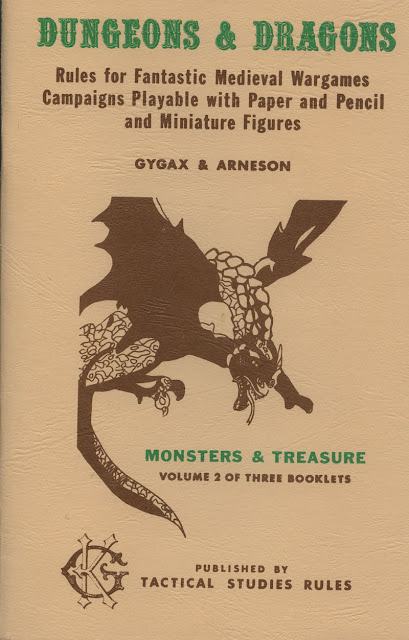Chapter 6
SEARCHING AND RESEARCHING
One should place limits on one's expectations of Gary in this chapter, to be fair. These limits have to do with the fact that he is trying to cover both searching through the RPGs available at the time and researching to enhance one's gaming. RPGs have gone out of print and yet the total number has greatly proliferated, so it is not possible that Gary's survey of available games should be particularly helpful today, outside of those who will find it helpful to see what games Gary mentioned among those available to him when he is writing in '86/87. In my treatment of this chapter, I am going to ignore the aspect of the chapter that surveys the field, except to note the range of genre that Gary sets out. I will give into my mono-game-ist tendency and only refer to D&D and AD&D specifically, which Gary notes are "the most popular RPGs" (105).
The Different Types of Games: Specific Genres of RPGs
- Fantasy
- Science Fantasy and Science Fiction (pure SF, post-holocaust, horror)
- Superhero
- {Time travel}
- Espionage
- Detective
- Historical
"Fantasy is at once the umbrella term that covers all role-playing games and one of the genres under that umbrella. All RPGs are fantastic in the sense that they depict game worlds, not real ones" (105). The specific genre term, though, refers to a game world in which the natural laws governing our real world do not fully apply or are supplemented by other laws that are not part of our reality. Such as: magic, legendary heroes, mythical beings, and extraordinary feats. These worlds may be amalgamations of myth, legend, and folklore. They may be "wide-scope" amalgamations (D&D is singled out here) or focused on some specific body of material (Norse saga and Arthurian legend are offered as examples). The other option for a fantasy world is a specialty, original world created by an author, game designer, or GM to have its own unique identity.
The distinction that would bring Gary's treatment into to greater focus would be between researching games and researching world. He has in mind that for
mastery, the expert will be a student of both gaming and genre. In addition to having some understanding of other games and how they work to enrich your running of your own game, the expert (or the enthusiast -- the aspiring expert) will study the cultures, societies, and ecologies (111) relevant to the genre of one's game.
Knowing the Word of Your PC
It is easy to get excited about the educational thrust of the chapter. For Gary, learning is not only relevant but fun in and of itself. But to the relevance:
"As a participant in a role-playing game campaign, you must be an expert on the world in which your game persona lives and has adventures" (112).
"The great majority of role-playing games do not attempt to simulate precisely some certain aspects of reality or history...Complete immersion in the make-believe world actually requires a fair amount of real knowledge. Even as whimsical a milieu as the fantasy world requires a firm background knowledge of many subjects" (113).
Gary recommends by name the following books for "the serious participant in a game such as Dungeons & Dragons" (Ibid):
A History of the Art of War in the Middle Ages [by C.W.C. Oman]
Town Government in the Sixteenth Century [by James Henry Thomas]
The Domesday Book
The Welsh Wars of Edward II [? Surely he meant Edward I]
Numbers in History [presumably, THIS one]
This list of five books is intriguing, and I guess it is unrealistic to wish for a bibliography, since it would have obliged Gary to have given one for each genre, so I shall not be churlish. Elsewhere (116), he mentions the
Boy Scout Handbook and the
Army Survival Manual as helpful works to consider.
Above all, "What is needed is a program of expanding your learning... [a] program you establish [which] will be entirely self-imposed and self-directed," making you of the time and materials available to you and relevant to your game world. Gary does set out the broad outlines of such a program. It does seem to me that he achieved a very tight outline, but I will reproduce the lineaments of it below. (It is also unclear exactly how what is below is related to his distinction between primary, secondary, and tertiary sources.)
Outline of Study for Mastery
I. Primary Source Material of the Game Milieu
For AD&D, Gary identified the following must haves: Dungeon Master's Guide, Players Handbook, one or more of Monster Manual, Monster Manual II, or Fiend Folio.
Optional sources (depending on level of detail desired & on milieu): Legends & Lore, Dungeoneer's Survival Guide, Wilderness Survival Guide, Oriental Adventures.
II. Inspirational Reading
Appendix N territory
III. Gaming Materials
IV. Supporting Leisure-Time Activities
Reading, TV & film, travel, museums, etc.
V. Development of a Research Collection
So, get out there and research "Armor, weapons, siegecraft, costume, agriculture, politics, heraldry, and warfare" (113); "mythology, metaphysics, philosophy, psychology, and physics" (115). Your "giants, dragons, magicians, wicked witches, and enchantments" (113) will thank you, your game members will thank you, and so will we, if you blog about it.









































